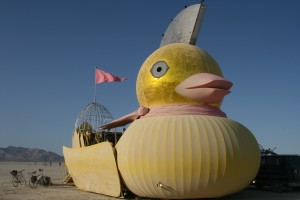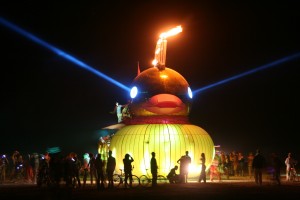As suggested by Kim “Skipper” Corbin and Celina Su, I’ve created a facebook group page for the book. Find out more about what other people think about their Burning Man volunteer experiences, upcoming events, etc.
Re-evaluate your expectations: this is Burning Man, not McDonalds
Many of us have expectations for speedy service with no surprises. For example, at fast food restaurants, we know how to line up, order our desired meal combination by number, and bus our own tables. In return, we get a standardized product or service delivered within minutes. For better or worse, expectations for these kinds of experiences have spread to other parts of our lives – speed dating, “quality time” with the kids or significant other, etc.*
Burning Man offers an opportunity to re-evaluate these expectations. The Burning Man organization is urging that arrivals at Burning Man respect the following guidelines regarding entry into the event. I’ve put the full item below in quotes, with my own illustrative photo inserted:
“BURNING MAN: WHAT TO EXPECT AT THE GATE
Here’s some tips on what to expect at the Gate when arriving at Black
Rock City and how to make the process go as smoothly as possible for
you:
#1. BE ON TIME
No one likes an ‘Early Emily’.
Please, do not plan to arrive, and DO NOT arrive at BRC until you are
allowed to be there. The event opens at 12:01am on MONDAY August 31st.
Showing up early may actually cause you to get into the event later
than if you show up on time. Stop somewhere and take a break if it
looks like you will arrive early rather than drive 2 hours to BRC only
to be turned around. You will save yourself a lot of frustration. IF
YOU ARRIVE BEFORE 12:01AM YOU WILL NOT BE ALLOWED INTO THE EVENT AND
YOU WILL NOT BE ALLOWED TO WAIT AT THE GATE.
#2. BE PREPARED.
Don’t be a ‘Disorganized Danny’.
When you roll up to the playa, have your ticket and any applicable
paperwork (copy of mutant vehicle registration, early arrival pass,
etc.) in your hand. Not your friends’ hands, not in your trunk, not in
your friend named Hans’ trunk. Be prepared to show your ticket to the
Gate volunteer as soon as you hit the gravel (heck, get it ready in
Gerlach!).
Your car will be searched at the Gate. Keep this in mind when packing
and the search will be easier for everyone, which means you get
through faster. If you have a large vehicle or a lot of stuff, we
appreciate it when you help us during the search! Read the Survival
Guide and know what items are not allowed into BRC!

#3. BE AWARE
Don’t be an ‘Uninformed Ursula’.
Buying a ticket or picking up a Will Call ticket?: stay in the FAR
RIGHT LANE on Gate Road and look for the entrance to the Will Call
Lot. Go to Will Call/Box Office, get your tickets and then get in
line. Everyone in your vehicle must have a ticket in hand when you
reach the Gate or your entire car will be turned around! Do not add an
hour (or more!) to your wait time. Don’t get searched twice! Head to
will call, get the tickets, and get in line – but don’t get in line
without all your tickets!
#4. BE REALISTIC
No one enjoys a ‘Frustrated Ferguson’.
Thousands of people arrive in the first 18 hours of opening. If you
arrive during these hours, expect a long wait at the Gate. If you want
a smoother and faster entry, consider arriving after the initial rush.
If you are going to arrive in the hours after opening, plan to enjoy
the wait. This is also true for Exodus – avoid leaving during the peak
afternoon times on Sunday and Monday if you want your best chance at a
shorter line. You have been warned!
#5. BE PATIENT
No one likes a ‘Grumpy Gateperson’, just like no one likes an ‘Angry
Allen’ or ‘Mean Mary’.
The Gate folks are VOLUNTEERS. They donate their time to help you get
in to Black Rock City! If you’re patient with them, they will be
patient with you. Remember, no one likes a ‘Dishonest Denise’ or a
“Fencehopping Freddy’. Please, be patient, play nice and wait your
turn. Cutting in line and running through fences not only makes you
lame, it will guarantee that you get into the event a LOT later than
you planned.”
Here’s my added tip for those who want to share the Burning Man spirit: gift the folks at the Gate (those who collect your tickets) and the Greeters (those who welcome you to Burning Man and provide late-breaking information) with something special. Your gift could be a heartfelt smile, a cool drink, or a handmade trinket.
* See George Ritzer’s (2004) The McDonaldization of Society. Pine Forge Press.
Dress code: clashing print day!
This WSJ article depicts a Japanese brokerage firm’s efforts to incorporate American employees of the now-defunct Lehman Brothers. Here’s an excerpt from the article, which shows the difficulties of integrating companies and practices:
“Some Nomura managers interpreted strictly the company’s dress code for women. They told women joining from Lehman to remove highlights from their hair, to wear sleeves no shorter than midbicep and to avoid brightly colored clothing, according to several people who joined from Lehman. Several women were sent home from the trading floor for dressing “inappropriately,” these people say.
“I was sent home for wearing a short-sleeve dress, even though I was wearing a jacket,” says one woman who says she plans to leave as soon as she receives her final guaranteed bonus payment.
Nomura’s human-resources department changed some women’s email addresses to their married names, from their maiden names, without asking which names they used professionally, according to the people who joined from Lehman.
The Nomura spokeswoman says the dress code is displayed on the company’s intranet and is intended to ensure that clients and colleagues don’t feel uncomfortable. The email addresses were changed because of a problem during the transition process, she says, adding that she doesn’t know whether the complaints about them have been addressed.”
I could comment about many things about these reported practices. For instance, Nomura seems to suffer from over-organizing’s coercive control: the gendered responsibilities, the sanctioning of those who don’t conform to a strict dress code, and the changing the maiden name to a married name (in academia, many of us don’t change our last names, in part, because we have a professional identity as published researchers).
However, since I am in NYC, a fashion and finance capital, I will focus only on the dress code issue. Obviously, the Nomura managers have never tried to shop for women’s career wear – if they had, they would know the difficulties of finding flattering items sans color. A lack of official dress code is one of the many reasons why I chose to work in academia – a stint at a discount retailer store, in which I had to wear pantyhose, made me swear that I would never, ever work at a place that demanded hosiery as part of its dress code. Life is just too short to stuff yourself into plastic, unless it’s for, uh, fun.
Just for contrast: instead of “casual Fridays,” the Burning Man organization had “animal print” or “clashing print” days.
Tip for the Lehman folks under the new regime – want subtle ways of dissenting at work and undermining an overbearing boss? Read:
Yuko Ogasawara’s (1998) Office Ladies and Salaried Men: Power, Gender, and Work in Japanese Companies. Berkeley: University of California Press.
Why write a book about the Burning Man organization?
Organizations impact the quality of our lives. We spend most of our waking hours running or interacting with schools, workplaces, voluntary associations, governmental agencies, and organizations. At times, we may feel disappointed or depleted by our organizational experiences. At worst, we may be exploited or harmed by organizations, including those intended to represent our interests. Think of people who hate their jobs, or people who feel alienated in their churches or voluntary associations, or people whose interests have not been adequately served by governmental agencies.
Past studies have showed various ways in which organizations have failed us, but they don’t usually offer concrete ideas about how an organization can be more responsive to our needs and interests. Enabling Creative Chaos: The Organization Behind the Burning Man Event offers a chance to imagine possibilities.*
Like any collectivity, the Burning Man organization has faced several organizing challenges. Its members have grappled with how to incorporate different perspectives about how to organize, how to recruit, place, and motivate volunteers, and how to coordinate with sometimes uncooperative organizations. Early on, Burning Man suffered from under-organizing, or insufficient structures and coordination. As the organization grew, members risked over-organizing by adopting too many structures or introducing coercive control.
In navigating the shoals of under and over-organizing, Burning Man developed an enabling organization that supported, rather than constrained, members’ efforts. This organization’s development offers valuable lessons about organizations can thrive, even during uncertain times.
* In sociological parlance, my study is a normative case, as it focuses on how organizations can realize our ideals. See David Tacher’s (2006) “The Normative Case Study” in American Journal of Sociology 111(6): 1631-1676.
Paperback NOW available from the University of Chicago Press distributor
Building on my recent post about the distribution of books…
Exciting news! I just spoke with the distributor for the University of Chicago Press. The paperback version of my book is now available, as of today July 24, 2009! (The hard covers are in, but need to be labeled first).
The ISBN for the paperback is: ISBN: 978-0-226-10238-2
The ISBN for the hard cover is: ISBN: 978-0-226-10237-5
You can call toll-free, 1-800-621-2736, M-F 8:30-5pm CST to place your order. They take credit card orders.
Paperbacks cost $25. Shipping by FedEx/UPS is $5 for the first copy and $1 for each additional copy. For large orders, they may charge at-cost shipping rather than per book.
For those of you going to the American Sociological Association (ASA) conference on Aug. 8-11, 2009, you can submit a paper order at the University of Chicago Press booth, for a 20% discount and with free shipping.
Any questions? Please add a comment.
Organizations and the distribution of goods
Once the writing is done, the hard part is making sure potential readers know of your writing’s existence. With the simultaneous decline of independent bookstores and the rise of Amazon and chain bookstores, buyers who like to browse through books, as opposed to pointing and clicking, may find the selection to be limited to mainstream best sellers.
While searching what online merchants are offering Enabling Creative Chaos, I was mystified by the book’s presence on one vendor’s website: Target. I subsequently found this New York Times article, which explains how the discount retailer has managed to cultivate buyers for books that might not sell in such large numbers elsewhere.
I’m guessing that my book is being sold online through a link via Amazon, but if anyone sees Enabling Creative Chaos on a Target shelf or display, snap a photo and let me know!
Preview of Enabling Creative Chaos book cover
I’ve posted the image for the cover and the spine for my book Enabling Creative Chaos: The Organization Behind the Burning Man Event here.
The cover shows the bonfire of the Temple of Forgiveness, which was designed and constructed by David Best and Tim Dawson, at the 2007 Burning Man. This image, which was taken by Waldemar Horwat, is a nice complement to the black and white photo of the temple before its bonfire which appears inside the book. David Best won’t be at Burning Man this year, but he continues to build his elaborate works, all dedicated to the passing of loved ones, around the world. A documentary about his work is available here.
For more images of Burning Man from the official Burning Man website, click here.
Walks like a duck, talks like a duck, must be a…
Some believe that organizations should look like what they produce. For example, members of groups that pursue civil rights, women’s rights, or countercultural goals want their organizational practices to reflect these egalitarian goals. They therefore adopt democratic or collectivist practices like decision making by consensus. The Burning Man organization has faced similar demands for collectivist practices. On the other hand, a minority of persons believe that a seemingly spontaneous event should have no organization at all.
Architecture has a similar concept about structure reflecting production, as evidenced by the following:

The above Long Island duck, which used to sell ducks and duck eggs, now vends trinkets to tourists in Flanders, Long Island, New York.
Here’s a 2008 Burning Man version of the duck as an art car: 

Cash is King
Volunteer labor can only support an organization so far. Without a steady source of revenue, an organization may not survive for long. Most organizations, including those not intended for profit, engage in some sort of commerce. In the U.S., governmental funding and philanthropy can provide funds, but not on a long-term basis. Therefore, museums run gift shops; universities host executive education programs and other summer camps; public transportation agencies sell opportunities to name their stations; non-profit associations might lend their trusted names to flog unrelated products and services. However, these extra activities may detract from an organization’s mission, or what some have dubbed “mission creep.”
An unusual opportunity to support the operating costs of the home and studio of artists Jackson Pollack and Lee Krasner in East Hampton, NY:

In contrast, the Burning Man organization is unusual in that its budget is derived from event ticket sales, rather than say, governmental grants or corporate sponsorship. This protects the organization against the demands associated with pursuing and maintaining governmental funding or corporate sponsors.
